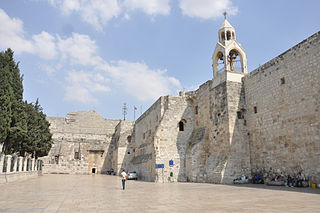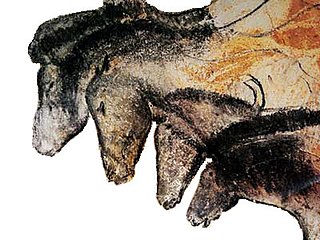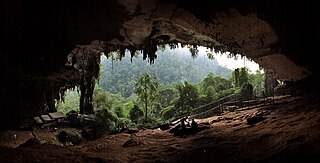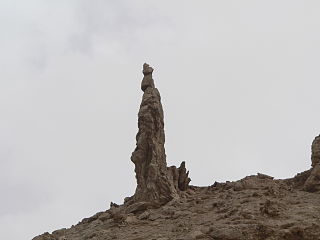Related Research Articles

Petra, originally known to its inhabitants as Raqmu or Raqēmō is a historic and archaeological city in southern Jordan. It is adjacent to the mountain of Jabal Al-Madbah, in a basin surrounded by mountains forming the eastern flank of the Arabah valley running from the Dead Sea to the Gulf of Aqaba. The area around Petra has been inhabited from as early as 7000 BC, and the Nabataeans might have settled in what would become the capital city of their kingdom as early as the 4th century BC. Archaeological work has only discovered evidence of Nabataean presence dating back to the second century BC, by which time Petra had become their capital. The Nabataeans were nomadic Arabs who invested in Petra's proximity to the incense trade routes by establishing it as a major regional trading hub.

The Church of the Nativity, or Basilica of the Nativity, is a basilica located in Bethlehem in the State of Palestine, in the West Bank. The grotto holds a prominent religious significance to Christians of various denominations as the birthplace of Jesus. The grotto is the oldest site continuously used as a place of worship in Christianity, and the basilica is the oldest major church in the Holy Land.

Al-Aqsa Mosque, properly Jāmiʿ al-Aqṣā, also known as the Qibli Mosque or Qibli Chapel, is a congregational mosque or prayer hall in the Old City of Jerusalem. In some sources the building is also named al-Masjid al-Aqṣā, but this name and its English translation "Al Aqsa Mosque" itself, is disputed as it can instead apply to the whole compound in which the building sits. The wider compound is also known as the Haram al-Sharif, the Al-Aqsa Mosque compound, and the Temple Mount.

In archaeology, cave paintings are a type of parietal art, found on the wall or ceilings of caves. The term usually implies prehistoric origin, and the oldest known are more than 40,000 years old and found in the caves in the district of Maros. The oldest are often constructed from hand stencils and simple geometric shapes. More recently, in 2021, cave art of a pig found in Sulawesi, Indonesia, and dated to over 45,500 years ago, has been reported.

The Chauvet-Pont-d'Arc Cave in the Ardèche department of southeastern France is a cave that contains some of the best-preserved figurative cave paintings in the world, as well as other evidence of Upper Paleolithic life. It is located near the commune of Vallon-Pont-d'Arc on a limestone cliff above the former bed of the river Ardèche, in the Gorges de l'Ardèche.

Lalibela is a town in the Amhara Region of Ethiopia. Located in the Lasta district and North Wollo Zone, it is a tourist site for its famous rock-cut monolithic churches. The whole of Lalibela is a large and important site for the antiquity, medieval, and post-medieval civilization of Ethiopia. To Christians, Lalibela is one of Ethiopia's holiest cities, and a center of pilgrimage.

The archaeology of Israel is the study of the archaeology of the present-day Israel, stretching from prehistory through three millennia of documented history. The ancient Land of Israel was a geographical bridge between the political and cultural centers of Mesopotamia and Egypt. Despite the importance of the country to three major religions, serious archaeological research only began in the 15th century. Although he never travelled to the Levant, or even left the Netherlands, the first major work on the antiquities of Israel is considered to be Adriaan Reland's Antiquitates Sacrae veterum Hebraeorum, published in 1708. Edward Robinson, an American theologian who visited the country in 1838, published its first topographical studies. Lady Hester Stanhope performed the first modern excavation at Ashkelon in 1815. A Frenchman, Louis Felicien de Saucy, embarked on early "modern" excavations in 1850. Today, in Israel, there are some 30,000 sites of antiquity, the vast majority of which have never been excavated.

Kadisha Valley, also romanized as the Qadisha Valley and also known as the Kadisha Gorge or Wadi Kadisha, is a gorge that lies within the Bsharri and Zgharta Districts of the North Governorate of Lebanon. The valley was carved by the Kadisha River, also known as the Nahr Abu Ali when it reaches Tripoli. Kadisha means "Holy" in Aramaic, and the valley is sometimes called the Holy Valley. It has sheltered Christian monastic communities for many centuries. The valley is located at the foot of Mount al-Makmal in northern Lebanon.

Umm ar-Rasas, ancient name: Kastron Mefa'a, is located 30 km southeast of Madaba in the Amman Governorate in central Jordan. It was once accessible by branches of the King's Highway, and is situated in the semi-arid steppe region of the Jordanian Desert. The site has been associated with the biblical settlement of Mephaat mentioned in the Book of Jeremiah. The Roman military utilized the site as a strategic garrison, but it was later converted and inhabited by Christian and Islamic communities. In 2004, the site was inscribed as a UNESCO World Heritage Site, and is valued by archaeologists for its extensive ruins dating to the Roman, Byzantine, and early Muslim periods. The Franciscan academic society in Jerusalem, Studium Biblicum Franciscanum (SBF), carried out excavations at the north end of the site in 1986, but much of the area remains buried under debris.

Niah National Park, located within Miri Division, Sarawak, Malaysia, is the site of the Niah Caves limestone cave and archeological site.

Gorham's Cave is a sea-level cave in the British overseas territory of Gibraltar. Though not a sea cave, it is often mistaken for one. Considered to be one of the last known habitations of the Neanderthals in Europe, the cave gives its name to the Gorham's Cave complex, which is a combination of four distinct caves of such importance that they are combined into a UNESCO World Heritage Site, the only one in Gibraltar. The three other caves are Vanguard Cave, Hyaena Cave, and Bennett's Cave.
Discoveries in the Judaean Desert (DJD) is the official 40-volume publication that serves as the editio princeps for the Dead Sea Scrolls. It is published by Oxford University Press.

Alahan Monastery is a complex of fifth century buildings located in the mountains of Isauria in southern Asia Minor. Located at an altitude of 4,000 ft, it stands 3,000 ft over the Calycadnus valley and is a one-hour walking distance from the village of Geçimli. Although termed a monastery in many sources, this attribution is contested and more recent scholarship consider it to be a pilgrimage shrine. The complex played a significant role in the development of early Byzantine architecture, and practically everything known about it can be attributed to the excavations of Michael Gough.

The Monastery of St Lot is a Byzantine-period monastic site near the Dead Sea in Jordan, at the entrance to a natural cave, which Christians believed to have been the one where Lot and his daughters sought shelter after Sodom was destroyed. The monastery, dating to the 5th-7th centuries, is centered around a basilical church and overlooks from a steep slope the southeastern Dead Sea and the modern town of Safi in Jordan.

Al-Maghtas, officially known as Baptism Site "Bethany Beyond the Jordan", is an archaeological World Heritage Site in Jordan, on the east bank of the Jordan River, considered to be the original location of the Baptism of Jesus by John the Baptist and venerated as such since at least the Byzantine period. The place has also been referred to as Bethabara and historically Bethany.

Vanguard Cave is a natural sea cave in the British Overseas Territory of Gibraltar which is part of the Gorham's Cave complex. This complex of four caves has been nominated as a UNESCO World Heritage Site status in 2016. The cave complex is one of the last known habitations of the Neanderthals, with a period of inhabitation from 55,000 to 28,000 years ago. It is located on the southeast face of the Rock of Gibraltar.

Coliboaia Cave is located in Apuseni Natural Park, Câmpani, Bihor County, Romania. It may contain the oldest known cave paintings of Central Europe, radiocarbon dated to 32,000 and 35,000 years BP, corresponding to the Aurignacian and Gravettian cultures of the Paleolithic period.

Archaeology of Qatar as a field study began in 1956. Three major expeditions were carried out in Qatar throughout the mid-20th century, with the first being launched by a Danish team who began work in the 1950s. This was followed by British and French expeditions in 1970s and 1980s, respectively. Approximately 200 archaeological sites were discovered during these expeditions, with the most extensive being the coastal areas of Al Da'asa, Ras Abrouq and Al Khor Island. Artifacts such as flint tools, Ubaid and Barbar pottery and encampments were found in situ.
References
- 1 2 Milstein, Mati (13 June 2008). ""Oldest Church" Discovery "Ridiculous," Critics Say". National Geographic . Archived from the original on 2008-11-08.
- ↑ "UNESCO, GIZ preserve unique mosaic heritage in Rihab". UNESCO. 8 March 2021.
- ↑ "Hatay, St. Pierre Church". UNESCO World Heritage Convention. Tentative Lists. 15 April 2011.
- ↑ McGrath, Matt (10 June 2008). "Jordan cave may be oldest church". BBC News .
- ↑ "Doubts Raised About Ancient Christian Shrine in Jordan". Fox News . 12 June 2008. Archived from the original on 2014-11-08.